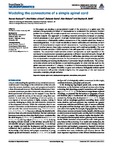Modeling the connectome of a simple spinal cord.
| dc.contributor.author | Borisyuk, R | en |
| dc.contributor.author | Al Azad, AK | en |
| dc.contributor.author | Conte, D | en |
| dc.contributor.author | Roberts, A | en |
| dc.contributor.author | Soffe, SR | en |
| dc.date.accessioned | 2017-05-10T15:48:23Z | |
| dc.date.available | 2017-05-10T15:48:23Z | |
| dc.date.issued | 2011-09-23 | en |
| dc.identifier.uri | http://hdl.handle.net/10026.1/9222 | |
| dc.description.abstract |
In this paper we develop a computational model of the anatomy of a spinal cord. We address a long-standing ambition of neuroscience to understand the structure-function problem by modeling the complete spinal cord connectome map in the 2-day old hatchling Xenopus tadpole. Our approach to modeling neuronal connectivity is based on developmental processes of axon growth. A simple mathematical model of axon growth allows us to reconstruct a biologically realistic connectome of the tadpole spinal cord based on neurobiological data. In our model we distribute neuron cell bodies and dendrites on both sides of the body based on experimental measurements. If growing axons cross the dendrite of another neuron, they make a synaptic contact with a defined probability. The total neuronal network contains ∼1,500 neurons of six cell-types with a total of ∼120,000 connections. The anatomical model contains random components so each repetition of the connectome reconstruction procedure generates a different neuronal network, though all share consistent features such as distributions of cell bodies, dendrites, and axon lengths. Our study reveals a complex structure for the connectome with many interesting specific features including contrasting distributions of connection length distributions. The connectome also shows some similarities to connectivity graphs for other animals such as the global neuronal network of C. elegans. In addition to the interesting intrinsic properties of the connectome, we expect the ability to grow and analyze a biologically realistic spinal cord connectome will provide valuable insights into the properties of the real neuronal networks underlying simple behavior. | en |
| dc.format.extent | 20 - ? | en |
| dc.language | eng | en |
| dc.language.iso | eng | en |
| dc.subject | axon growth | en |
| dc.subject | connections | en |
| dc.subject | developmental approach | en |
| dc.subject | spinal cord | en |
| dc.subject | tadpole | en |
| dc.title | Modeling the connectome of a simple spinal cord. | en |
| dc.type | Journal Article | |
| plymouth.author-url | http://www.ncbi.nlm.nih.gov/pubmed/21977016 | en |
| plymouth.volume | 5 | en |
| plymouth.journal | Front Neuroinform | en |
| dc.identifier.doi | 10.3389/fninf.2011.00020 | en |
| plymouth.organisational-group | /Plymouth | |
| plymouth.organisational-group | /Plymouth/Faculty of Science and Engineering | |
| plymouth.organisational-group | /Plymouth/Users by role | |
| plymouth.organisational-group | /Plymouth/Users by role/Researchers in ResearchFish submission | |
| dc.publisher.place | Switzerland | en |
| dc.identifier.eissn | 1662-5196 | en |
| dc.rights.embargoperiod | Not known | en |
| rioxxterms.funder | Biotechnology and Biological Sciences Research Council | |
| rioxxterms.identifier.project | A neuronal network generating flexible locomotor behaviour in a simple vertebrate: studies on function and embryonic self-assembly | |
| rioxxterms.versionofrecord | 10.3389/fninf.2011.00020 | en |
| rioxxterms.licenseref.uri | http://www.rioxx.net/licenses/all-rights-reserved | en |
| rioxxterms.type | Journal Article/Review | en |
| plymouth.funder | A neuronal network generating flexible locomotor behaviour in a simple vertebrate: studies on function and embryonic self-assembly::Biotechnology and Biological Sciences Research Council | en |
| plymouth.funder | A neuronal network generating flexible locomotor behaviour in a simple vertebrate: studies on function and embryonic self-assembly::Biotechnology and Biological Sciences Research Council | en |


